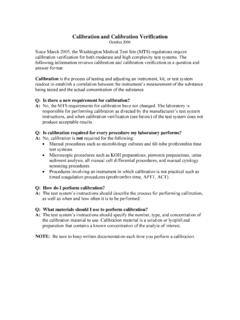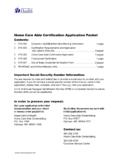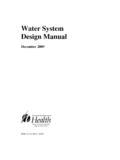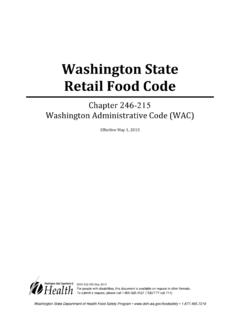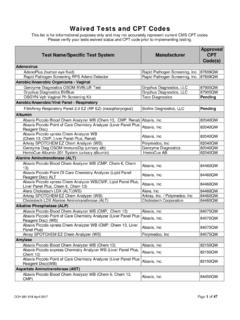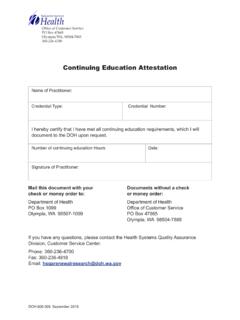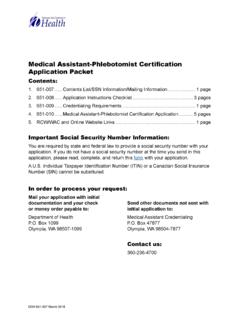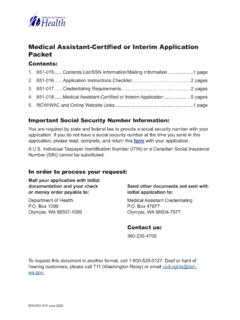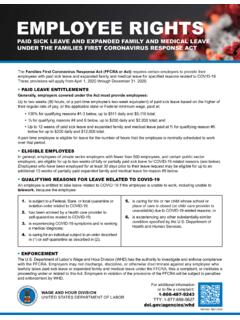Transcription of Child Care, Youth Development and Day Camps during COVID …
1 September 13, 2021. DOH 820-099. Guidance for Child Care, Youth Development , and Day Camps during COVID -19. Summary of September 10, 2021 Changes Reorganization of content to follow priority of recommendations in line with CDC. Resources and information on vaccination for eligible and mandated groups. Updated recommendations for cohorting and physical distancing. Updated recommendations for symptom monitoring/health screening at home. Added information on communicating and reporting cases. Updated recommendations on quarantine for fully vaccinated individuals. General alignment with language for K-12 settings where relevant. Introduction This guidance focuses on practices for children and Youth activities that lower the risk for spread of COVID -19. The more people interact with others from outside their own household or from a different cohort, the closer that interaction and the longer that interaction, the higher the risk of COVID -19 spread.
2 Children should only attend programs in their local, geographic area. As children are back to school for in-person learning and attending Child care or Youth Development in a different setting, it is important to limit social circles beyond these settings. COVID -19 vaccines are safe and effective. Everyone ages 12 years and older is recommended to be vaccinated against COVID -19 as soon as possible to keep from getting and spreading COVID -19. Consider surveillance or screening testing to monitor for asymptomatic infections. This health and safety guidance is based on existing science, expert public health opinion, current policies, and stakeholder input. As a business , Child care, Youth Development , and day camp providers must follow industry specific requirements and policies to maintain licensure as outlined by local, state, and federal entities .
3 Program Types Included in this Guide DCYF licensed Child care programs and the Early Childhood Education and Assistance Program (ECEAP). Licensed-exempt programs operated in a manner that complies with the Child and staff cohorting and group size recommendations in this guidance. Federally funded Head Start programs. Day Camps , including specialty Camps like sports Camps . Outdoor preschool programs, including part day license exempt programs. Parent cooperatives. Youth Development programs providing Child care and other basic supports to assist children and Youth access to remote K-12 instruction. Expanded learning opportunities, including programs for Youth that complement academic and/or social emotional learning, such as Boys & Girls Clubs, YMCA programs, and other culturally-based and identity-based programs. Programs funded under the federal Nita M.
4 Lowery 21st Century Community Learning Centers program. Enhanced learning academies, such as formal mentoring programs, tutoring centers, and college preparatory programs. Child care, Youth Development , and day Camps held in K-12 facilities. Not Currently Recommended License-exempt Child care programs where parents remain on-site for purposes other than employment, such as those in fitness centers, grocery stores, etc. Allowed Under Separate Guidance Activities not covered in this guidance, but addressed elsewhere, include businesses organized primarily for these purposes: Sports and Fitness Overnight Camps Activities included as part of K-12 basic education or special education programs Contents Summary of September 10, 2021 Changes .. 1. Introduction .. 1. Program Types Included in this 1. Not Currently Recommended .. 2. Allowed Under Separate Guidance.
5 2. General Guidance .. 3. Key Principles for Reducing Potential Exposures .. 3. Reducing Transmission .. 5. Promoting Vaccination .. 5. Fully Vaccinated ..5. Cloth Face 6. Cohorting/Assigning Staff and Children to Groups .. 7. Table 1: Grouping and Staff Ratios by Age Group ..7. Physical Distancing .. 8. Ventilation .. 9. Hygiene Practices .. 10. 2. Staying Home When Sick .. 11. Additional Considerations for Child Care Programs .. 11. Health Screening Before Entry/Drop-Off and Pick Up .. 11. Providing Staff Required Breaks .. 11. Outside Play .. 12. Meals and Snack Time .. 12. Infant and Toddler 12. Transportation .. 13. Responding to Cases or Suspected Cases of COVID -19 .. 13. What to do if Someone Develops Symptoms of COVID -19 While at Child Care .. 13. Isolation Space at a Facility ..13. Returning to a Child Care Program .. 15. Isolation.
6 15. What to Do if Someone is a Close Contact of Someone with COVID -19 .. 15. Get Tested for COVID -19 ..17. Child Care Closure in Response to COVID -19 Cases .. 17. Returning to a Program after Travel .. 18. Reporting Cases and Outbreaks and Working with Public 18. Reporting Requirements .. 18. Notify Public Health .. 18. Families and Child Care Staff Notification .. 19. General Cleaning and Disinfecting Procedures .. 19. Carpets .. 21. Outdoor Areas .. 21. COVID -19 Resources for Child Care, Youth Development and Day Camps .. 21. More COVID -19 Information and Resources .. 22. General Guidance Key Principles for Reducing Potential Exposures Promote vaccination. Vaccination is the most effective tool to prevent severe illness, hospitalization, and death from COVID -19. Vaccination can also reduce transmission. Many staff must be fully vaccinated by October 18 and all students 12 years of age and older are strongly recommended to get vaccinated.
7 Consistent and correct use of protective equipment. Use appropriate face coverings as recommended. Use cohorts. Conduct all activities in small groups that remain together over time with minimal mixing of groups. Physical distancing. Minimize close contact between people to the degree possible. Improve indoor ventilation and filtration systems. Open windows to the outside when possible. 3. Low-risk spaces. Consider outdoor activities when possible as they have less transmission risk than indoor activities. Respiratory etiquette and hand hygiene. Cover coughs and sneezes. Frequently wash hands with soap and water. Keep ill persons out of Child care. Educate children, families and staff to stay home when sick, and use screening methods. Isolation and quarantine. Isolate sick people and exclude people who should quarantine. Environmental cleaning and disinfection.
8 Prioritize the cleaning of high-touch surfaces. Increased interaction, close contact, and longer activities between people increase the risk of COVID -19 transmission. This health and safety guidance integrates recommendations from the CDC for mitigation measures in Child care. The CDC recommendations are general, and not intended to inform the appropriate level of Personal Protective Equipment (PPE) an employee needs, which should be made based on the tasks and situation. For employees, follow all Labor and Industries (L&I). guidance. Programs should also work with their Local Health Jurisdiction (LHJ) for any applicable local orders or requirements. Do not allow children, staff, vendors, parents/guardians, or guests on-site if they: Show symptoms of COVID -19; or Are not fully vaccinated and have been in close contact (within six feet for 15. cumulative minutes over a 24-hour period) with a COVID -19 case in the last 14 days.
9 Or Have tested positive for COVID -19 in the past 10 days or are awaiting results of a COVID -19 test due to possible exposure or symptoms and not from routine asymptomatic COVID -19 screening or surveillance testing; or Have been told by a public health or medical professional to self-monitor, self-isolate, or self-quarantine because of concerns about COVID -19 infection in the last 14 days. Please refer to Department of Health (DOH) guidance on screening for more information. Ensure staff are trained in health and safety protocols for your site. This includes: How to screen for symptoms. How to maintain physical distance. The use of appropriate personal protective equipment (PPE). Understanding and practicing frequent cleaning and handwashing. How to handle situations when someone develops signs of COVID -19. Communicate regularly with children and Youth , families and staff.
10 Emphasize the importance of: Getting vaccinated if eligible. Correct and consistent use of face coverings. 4. Using cohorts and maintaining physical distance. Improving ventilation. Handwashing and respiratory etiquette. Cleaning and disinfecting. Staying home when sick and seeking evaluation. Testing as indicated. Contact tracing in combination with quarantine and isolation. Responding to cases of COVID -19. Meeting the reporting requirements to public health. Communication should be provided using multiple methods, such as posters, written letters, email, text message, phone, video conferencing; and in the language that staff and parents best understand. Develop clear protocols for what and when you will communicate with staff and with families so they know where to find information and updates. Monitor Child and employee attendance and absences, have flexible leave policies and practices, and have access to trained substitutes to support employee absences.
